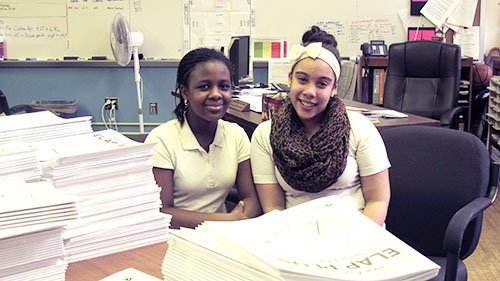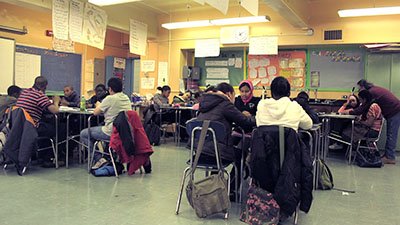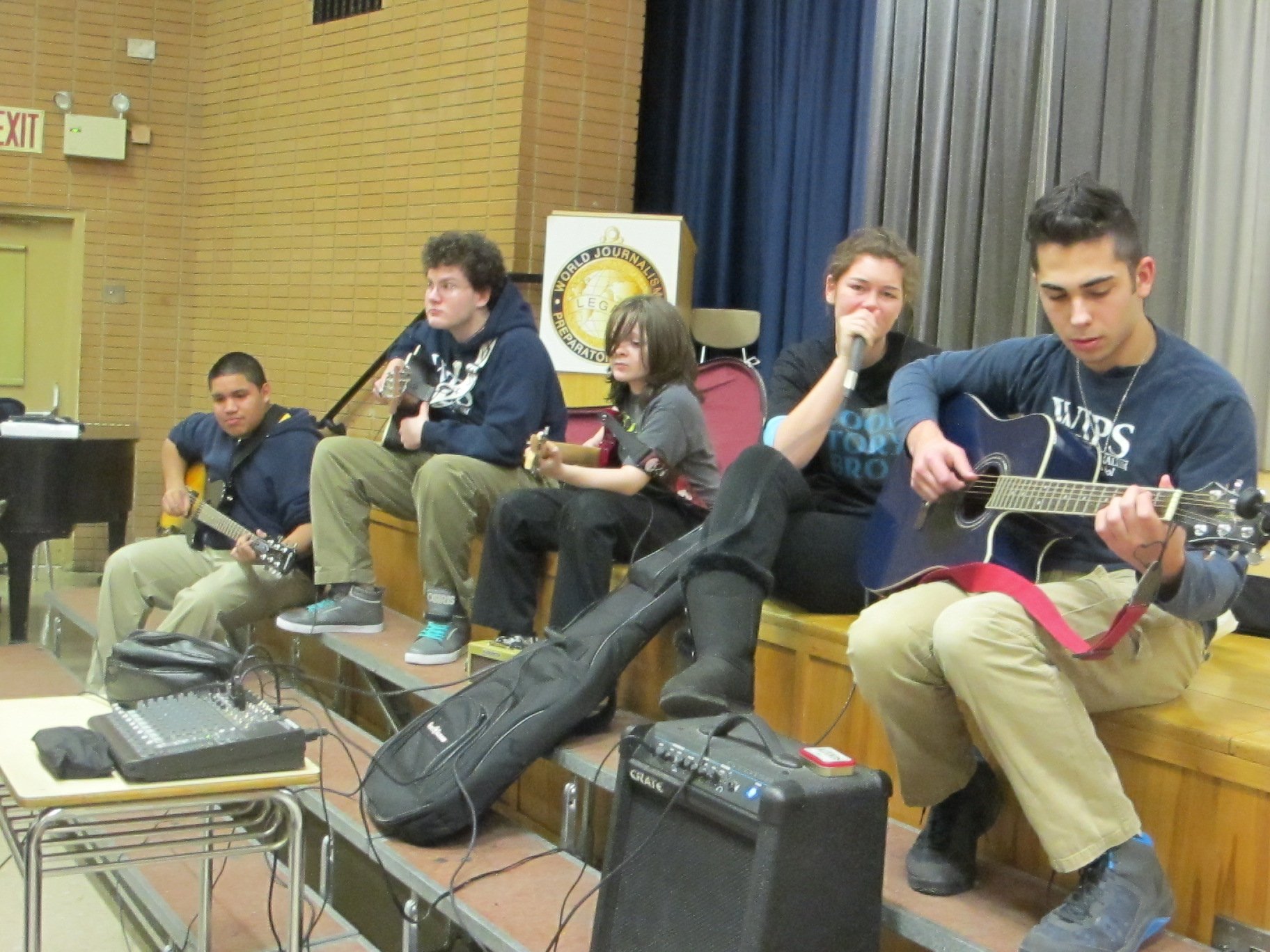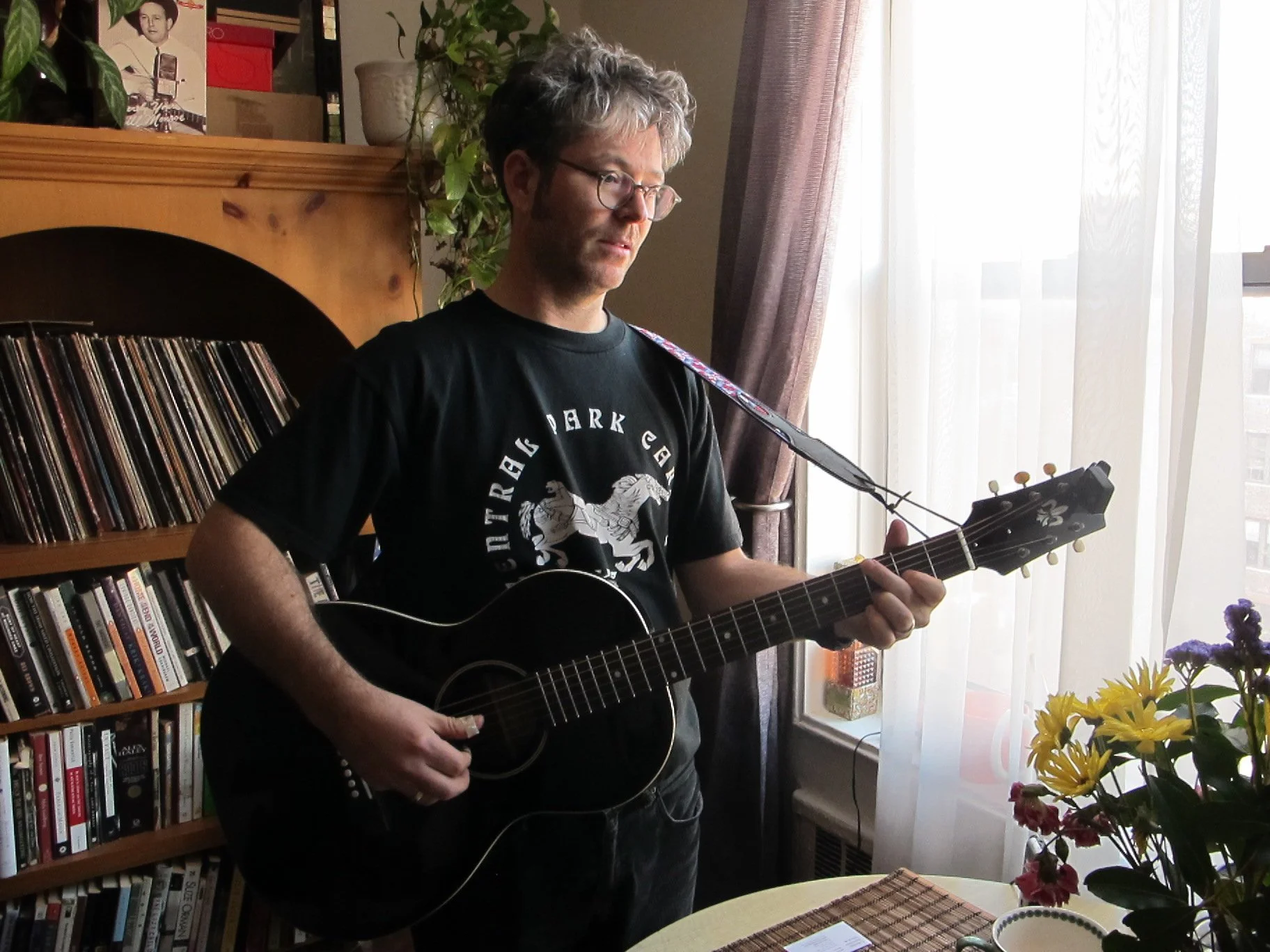Hawa Jalloh, left, shares a conversation in between classes with her best friend Yeimy Reynoso. These two MS 22 seventh graders attend DREAM prep classes together every Wednesday and Saturday.
Hawa Jalloh, far right, asks her DREAM prep math instructor for help on a lesson in polynomials during a Saturday session at South Bronx Academy for Applied Media.
DREAM: Prepping for Stuyvesant, Defying the Odds
APRIL 9, 2013
school-stories.org
Hawa Jalloh dodged groups of rowdy students as she wove her way through the crowded halls of Middle School 22 in the South Bronx one Monday morning in March. The seventh grader glanced into the assistant principal’s office where dozens of students were doing busy work – sharpening pencils and organizing office supplies, as penance for cutting class, something Jalloh could not imagine doing herself.
The plucky 13-year-old pressed into her seat in math class and opened her book, trying her best not to let the chaos around her interrupt her focus. Jalloh’s goal next year is to make it into Stuyvesant High School, one of New York’s eight selective public high schools.
Entrance to Stuyvesant and the seven other elite schools is based on a single 2.5 hour entrance exam, one that has increasingly led to a decline in the number of black and Latino freshmen over the last ten years. Jalloh faces great odds because Bronx middle schools send the fewest students to the selective high schools of any other borough. Only about 6 percent of the nearly 6,000 students admitted to the eight elite schools last year were from the Bronx, according to the Bronx Borough President’s office. Out of the 963 students accepted at Stuyvesant last month, only nine were black and 24 Hispanic, according to data released in March by the Department of Education.
But Jalloh believes she deserves the chance to be among the elite. Her high reading scores allowed her to enroll in the Department of Education’s specialized test prep program – a class that serves disadvantaged minority students who show potential for academic success but can’t afford private tutoring. Jalloh is one of only two students from her entire school who qualified for this program as a seventh grader.
On a cold Saturday afternoon in February, Jalloh awoke at 7 a.m. to take a train to the South Bronx Academy for Applied Media for four hours of math and English Language Arts prep at the Specialized High School Institute, or “DREAM” as it’s called, an acronym for Determination, Resilience, Enthusiasm, Ambition and Motivation. This chance for test prep opened up for her coincidentally. Until last year, the program only enrolled sixth graders, who were bused to one of the eight high schools for these Wednesday and Saturday sessions. This year, 18 sites were opened closer to the students’ homes, and seventh graders were admitted for the first time.
The program has gone through multiple changes in its leadership and curriculum in the last two decades. It began as a supplemental class for students who were falling behind in school, and later evolved into programs designed to build the foundations for test prep. Teaching in all subject areas was slowly whittled down to only help in English Language Arts and math – the two areas that are subject to standardized testing. It used to enroll all minority students, but it no longer admits Asians.
That morning, Jalloh walked into the school at Forest Avenue between Jackson and Trinton avenues to find only two-thirds of the students had shown up for the twice-a-week cram sessions. One student turned his back to the chalkboard, while another played games on his graphing calculator. Jalloh tried hard to pay attention, but she was distracted by the students and tired from staying up until midnight reading science fiction. She tapped her pencil on the table and tried to listen to her teacher, who was explaining how to solve polynomials, but her eyelids kept drooping and she kept falling behind.
“What’s the point of coming if you’re not engaged?” Jalloh said after class. “What we’re learning here is hard. And if you’re not going to pay attention, you might as well stay home.”
Jalloh said this course is her only chance to learn advanced math. Her teacher at MS 22 can’t help her further because she is on maternity leave. Jalloh didn’t feel comfortable turning to the substitute.
“In the beginning of class I’m more focused,” Jalloh said, even though she was hungry after eating only a bag of chips for breakfast. “During the middle of the class, the teacher adds more stuff on the board,” she said. “So that’s when it starts getting confusing, but I still catch up after looking closely at the board and trying to figure out how he got his answers.”
Although Jalloh is a bright and motivated student, the odds are not in her favor. If last year is any indication, enrollment in New York’s specialized high schools promises to become more competitive this year, and more racially skewed.
Only four percent of Stuyvesant students were black and Hispanic from 2008 to 2010, and the following year, that number dropped by one percent, according to the New York State School Report Card. Similarly, enrollment of minority students has declined in other elite high schools over the decade. At Brooklyn Technical High School, the number of black students dropped from 24 percent in 1999 to 10 percent in 2012, according to the Department’s enrollment demographics for that school.
These elite schools, which accept students based on their specialized high school test scores, continue to draw Asians at an increasing rate. At Stuyvesant last year, 72 percent of the students were Asian while 24 percent were white, 3 percent were Hispanic and 1 percent was black, according to the New York State School Report Card. The small numbers of black students who make the cut tend to find the race disparity to be alarming.
Last September, three civil rights and social justice organizations in New York City filed a federal civil rights complaint against New York’s Department of Education charging the city with barring low-income minority students from equal access to the top elite high schools. One key argument is that wealthier students have more opportunity to pay for private test preparation classes for the single admissions test required.
“We’re trying to hold the city and state accountable for a selection gap,” said Damon Hewitt, director of education practice at the NAACP Legal Defense Fund, one of the three legal counsels filing the lawsuit. “There are high achieving black and Latino students who are getting filtered out and not getting into the schools. The only basis to determine who gets into the schools is a single test.”
The standardized test for admissions to specialized high schools is “wrong on a number of fronts,” said Hewitt, adding that students who perform very well on one part of the exam and very poorly on another are more likely to get admitted compared to students who do equally well on both ELA and math but get only average scores.
In his 2008 case study on New York City’s specialized high school admissions, Deutsche Bank managing director and chief economist Joshua Feinman found that thousands of students who aren’t admitted into the elite schools have a “statistically indistinguishable” score from those who are admitted. That means these specialized high school exams, which are the sole determinant of admissions into the elite high schools, haven’t proven to be valid tools for measuring students’ achievement.
Malik Cayenne, a senior at Stuyvesant, is an anomaly. He is one of the few low-income minority students who did not take private test preparation for the exam because he didn’t want to give up his summers. He doesn’t believe in studying for standardized tests. You either know it, or you don’t he said.
Once he was accepted, he felt out of place. Students would ask ill-informed questions, like “Can you do the real Harlem Shake?” or “Where can I find the nearest KFC?”
“I thought, ‘Oh my gosh, am I the only black person at this school?’ Cayenne said. “It wasn’t until the start of the school year that I bumped into a few black people sitting outside the lunchroom and a few other people in an after school club that I began to feel comfortable.”
Few poor minority students can beat the odds like Cayenne, and most need a prep course like DREAM, which uses Kaplan’s test prep materials.
About 40 percent of the students in this DREAM program get accepted into a specialized high school, said math instructor Michael Cherubini, who has been teaching this prep course since it began. With the bar set fairly low for these students who are dedicating their time to prepare for the test, some show up to class an hour late or withdraw from the discussion altogether.
“On the first day I meet them, I say ‘I’m sure you know that out of all the people in here not 100 percent are going to go to Bronx Science, Stuyvesant, Tech or whatever else is out there,” Cherubini said. “But I say everybody here will profit from this experience. They’ll be some that make it, and they’ll be some that won’t. They all know that already. But they’re all here to learn more and that’s going to happen.”
Jalloh said that no matter where she goes she’ll be surrounded by people who are unmotivated to learn. And for now, she sits quietly in the back of the room doing her best to keep up in class, while managing her attitude and expectations.
“I think this program is giving me a leg up because everybody else is at home sleeping when I’m learning on Saturdays,” said Jalloh who was born in Guinea and lives with her dad who is a business man, her mom who is a nurse and five of her seven siblings in a neighborhood called Highbridge in the Bronx. “So I feel like I’m doing more than them, and I feel like I’ll have a better future than them.”
Despite the odds, she said she really wants to go to Stuyvesant, “but I won’t be that disappointed if I don’t because in the back of my mind, I have this voice telling me I might not pass it.”
Mobile Retail Shops Follow Food Trucks to the Streets
april 12, 2013
columbianewsservice.com
Nathan Fleischman always dreamed of starting his own business. As a kid, he pretended to own a burger joint and played fast food drive-through with his sister, passing cardboard burgers out of his first-floor bedroom window and depositing her make-believe change in an invisible register. Now 30, he's determined to take the idea of "drive through" a step further: instead of waiting for customers to drive to him, he wants to drive to them. And instead of selling burgers, he plans to sell sneakers. He's already raised more than $7,000 on Kickstarter to begin his central Missouri sneaker business on wheels.
Across the nation, mobile retailers are on the rise, said Stacey Steffe, a consultant at American Mobile Retail Association, an organization that serves the burgeoning number of retailers on wheels. Steffe knows of 110 retail trucks in the country but acknowledges that more surely exist. The industry gained momentum in 2010 after the recession pummeled brick-and-mortar stores, and vendors looked for ways to cut overhead. Now, retailers are setting up shop inside renovated Airstream trailers, former ice cream trucks and even old school buses. Some sell organic bath products, some sell bikinis, and still others serve as pet grooming parlors or law offices.
The mobile retail shops, which are building on the popularity of food trucks, provide a business model that allows customers to receive personal attention in a cozy shop, and allows owners to reap more of their profits. Plus, unlike small brick-and-mortar shops that provide similar services, these mobile businesses can head for customers instead of waiting for them.
"One of the biggest challenges of retail is getting people in the door," said Marshal Cohen, chief industry analyst at NPD Group, a New York-based company that provides consumer market research. "If I can bring the door to the people, I'm way ahead of the game."
Jennifer Kaplan began the Flower Truck in Los Angeles out of her 1970s Dodge ice cream truck on Valentine's Day 2011. Each morning, she opens her big truck windows to display 18 buckets of flowers and small vases on a wooden counter. Some of her customers are regulars - from middle schoolers to young men to senior citizens.
"I usually ask them to point to a flower that catches their eye," Kaplan said. "Then I pull that out, and then I say, 'Point to another one that you like,' and together we make an arrangement." She hopes to expand her flower business and has already sold her first franchise.
Sarah Ellison Lewis takes the idea of small items in small spaces a different direction. Her mobile store, Bootleg Market, touts an inventory of unusual, hand-made high heels from around the world displayed in a 30-foot Airstream trailer based in Austin, Texas. She launched her business in 2011, publicizing it at the New York and Paris Fashion Weeks after a dozen years as a fashion stylist.
Her store - in a 1968 Land Yacht - is as vintage as her merchandise, which includes modern products that resemble the retro styles of a bygone era.
Most retail shops on wheels limit their travel to a small radius, but some take their shop on the road, traveling hundreds of miles. Styleliner, which sells clothes and accessories from Europe, Africa and the Middle East, is in the Hamptons in summer, New York City in fall and Palm Beach in the winter and spring.
"With one truck, we're able to get to three cities, and it's so much more cost effective than three brick-and-mortar stores," said Sara Droz, the marketing director for Styleliner, which opened in June 2010.
Then there are mobile businesses that bring services to a customer's doorstep. Bark Bathe and Beyond Inc. is a dog grooming business that provides oatmeal baths and haircuts six days a week in Westchester County, N.Y., and Greenwich, Conn., two affluent regions where dog owners can afford to pamper their pooches by spending between $100 and $200 to clean their ears, clip their nails and bathe, blow dry and trim their fur. Rich Caporizzo, who bought a brand-new Ford van and had the roof chopped off to convert it into a doggie spa in 2006, has since bought two more vans.
"The struggle is you go to somebody's house, and they're not there," Caporizzo said. "And you drove all the way there, and you wasted all your time and money and gas. I try to eliminate that as much as possible, but even when I call up everybody the night before, it still happens."
Students at World Journalism Prep start jamming to “Should I Stay, or Should I Go” by The Clash.
Vincent Cross strums his guitar to one of his songs on his recent album “Home Away From Home”.
World Journalism Prep Students Sing the Blues
april 20, 2013
school-stories.org
Twelve-year-old James O’Neill perched next to his older brother, Will, strumming his guitar during lunch hour at World Journalism Preparatory School in Queens on a recent Friday in April. His shaggy brown hair fell over his eyes as he bobbed his head to “Should I Stay, or Should I Go,” by The Clash. A handful of other students unpacked guitars and drumsticks, getting ready to join in.
This lunchtime music club taught by a volunteer teacher is as good as it gets for the sixth through 12th graders in the Flushing school. It has no money to fund music classes in the school. The city has proposed cutting after school funds as well for next year.
“Schools have to meet art and music requirements,” said World Journalism Prep Principal Cynthia Schneider. “We meet our art requirement through our journalism curriculum and publication, but we have no budget for music. We have really talented kids here, but one of the things that kids give up when they go to a small school, is they give up the comprehensiveness of the large schools. The jam session on Fridays is the one outlet we have because we have one teacher who volunteers his lunchtime to do that.”
English teacher Vincent Cross instructs kids on his own time in blues rhythms and bluegrass, while jamming with them on his guitar. His mass of untidy curls obscures his face as he bobs to the students’ beat.
Cross came to World Journalism Preparatory after bouncing around the street musician circuit in London over a decade ago—an Irish youth, playing guitar. He said he doesn’t much mind donating his time to the cause of carving out some time for students to explore their musical ambitions, in unconventional ways.
And the jam sessions provide a safe place for unconventional students. “It took me a long time to get used to this school,” said James, as he put away his guitar. He said he used to get bullied because of his long hair. But once he realized the music interludes were for real, “it was the new ‘Call of Duty’ for me.” He was referring to the video game he plays an hour a day, until his mom tells him to put it away. The sedentary game time has now been replaced with practicing guitar.
Cross often brings in a few of the guitars he picked up at garage sales or on the streets, so students who don’t own an instrument can still jam along. One of his colleagues donated a drum set so that Vincent Ganpat, 17, could practice. Ganpat had been drumming since 8th grade when he found out about the music club through the school newspaper.
“Certain songs require certain beats,” Ganpat said, as he reflected on what he’s learned in the club so far. “I thought you could just use the same repetitive beat, but the drummer’s job is to make the sound fit. And in order to do that, you have to listen to how you’re playing and listen to everyone else.”
Nadine Cavanaugh, 17, was reluctant to join the group because she didn’t play an instrument. But she can sing, and she remains the only singer in the band. She looks forward to the Friday sessions, because she feels like she finally found a place where she belongs.
“I don’t have to refrain from being myself because other people won’t appreciate it,” she said, as she described how her involvement in the club has helped her feel socially accepted. “I was always the weird one. I’ve had Asperger syndrome since I was young. I’m the in-your-face kind of person, and that’s how I bond with people. Some people take it fine, and some can find it hard to handle.”
Cross knows something about being an outsider. Raised as an Irish immigrant in Australia until he was 10, he returned to his homeland only to be bullied at an all-boys Catholic elementary school for losing his Irish accent. Living in an apartment above his family’s pub, Cross fell in love with the records his parents had tossed away from the jukebox. While his classmates were grooving to 1980s pop songs, he was enjoying tunes from the 1950s. As if that weren’t odd enough, this Australian-Irish lad’s favorite music was pure Americana: bluegrass.
The hip 41-year-old journalism and English teacher received little support as a young, iconoclastic musician, so he wants to offer his students the opposite.
“They’re entering a musical journey, and I’d like to send them on their way,” Cross said. “Music brought things out and allowed me to access a deeper dimension of myself.”



